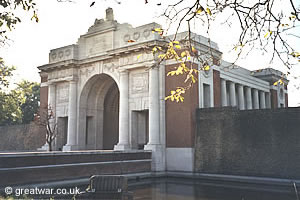History of the Menin Gate, Ieper (Ypres)
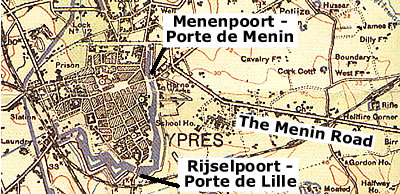
|
In medieval times the original narrow gateway on the east side of the city of Ieper (Ypres) was originally called the Hangwaertpoort. The word “Poort” is Flemish for “gate”.
At the outbreak of the First World War in August 1914 this eastern exit from the city was a cutting through the remains of the ancient ramparts. The road crossed the moat.
This cutting was known as the “Menenpoort” in Flemish or the “Porte de Menin” in French, which translates as the “Menen or Menin Gate”. In 1914 Menen was known by its French name of Menin. The road from this gateway leads north-east for about 150 metres (now called the Marshalk Frenchlaan). At the crossroads there is a right turn into the road leading to the town of Menen (Menin), some 16 kilometres (10 miles) away. From 1914-1918 this road became known to the British Army as The Menin Road.
1914
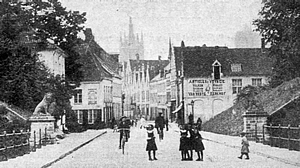 |
In 1914 two seated stone lions, one on each side of the gateway, guarded this eastern entrance to the city. The lions had originally been located either side of a set of steps at the Cloth Hall (the Lakenhalle). Before the First World War the steps were removed from the Cloth Hall and the two lions were relocated to the Menenpoort.
In the picture the lions are guarding the gate, looking outwards to the east of Ypres. The clock tower of the Cloth Hall's belfry can be seen in the centre of the picture. The pre-war square tower style spire of St. Martin's cathedral can be seen to the left of the tree on the right hand side of the picture. The ramparts on either side of the gate are grassed over and trees can be seen growing on them. The railings on either side of the road are to protect people from falling into the moat, which is this side of the ramparts.
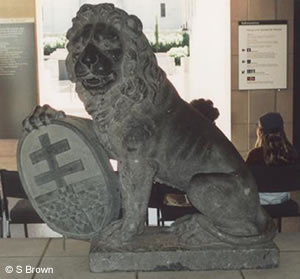 |
During the war both of the lions were removed from the gateway to prevent their destruction. In 1936 they were presented to the Australian nation by the Burgomeister (mayor) of the city of Ypres. Over 36,000 Australian soldiers were killed or wounded on the battlefields of the Ypres Salient, most of them during the battles in 1917. Over 6,000 of them have no known grave and are commemorated on the Menin Gate Memorial to the Missing, which now stands on the site of the old Menenpoort. The two original stone lions can now be found at the entrance to the Australian War Memorial museum in Canberra.
 |
The city of Ypres (Ieper) suffered the first serious damage to its buildings during the First Battle of Ypres (19 October - 22 November 1914). German artillery fired onto the city from its artillery positions in the north-east, east and south-east of the newly formed Ypres Salient. On 22 November 1914 the Cloth Hall (Lakenhalle) was set on fire by a German incendiary shell.
1915
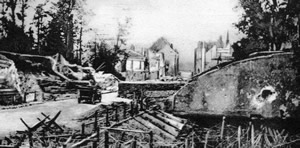 |
A few months later in the spring of 1915 an intensive German bombardment was started up onto the town. This was carried out by long range, heavy German artillery, which included a huge 42cm howitzer. This gun was nicknamed “Dicke Bertha” (which translates into English as big or fat Bertha) by the German Army. Consequently the gun became known as “Big Bertha” to the British Army. The bombardment was the prelude to the launch of a German gas attack on the Allied front line in the Ypres Salient on 22 April 1915. This was the beginning of the Second Battle of Ypres.
The photograph of the Menenpoort is not dated but is believed to have been taken in 1915, before the city was very badly damaged. The view is of the Menenpoort looking into the town. The location has suffered some damage by German artillery, but the trees are still standing on the ramparts and the road is still passable to vehicles. A barricade can be seen placed partly across the road through the gate. A large shell has landed in the brickwork of the rampart above the moat. The stone lions have been removed.
1917
During almost the whole period of the war thousands of United Kingdom and Commonwealth Forces marched through this gateway onto the Menin Road and roads leading into the battlefields of the Ypres Salient. The Third Battle of Ypres went on for several gruelling months between 31 July and 10 November, with hundreds of troops leaving the town to fight in the Ypres Salient. Many thousands would never return from these battlefields.
Many of the casualties were buried in marked graves in burial plots near to the fighting or taken to the rear areas to tend their wounds, where they died and were buried. However, in addition to these graves, the remains of over 90,000 British and Commonwealth soldiers were never found; they are either buried in marked graves with no identity or they still lie buried in the soil where they fell.
By 1917 damage from German artillery shelling had destroyed the houses in the street behind the gateway, giving a clear view through to the market square (Grote Markt) and the Cloth Hall (Lakenhallen). The trees on the ramparts were stripped of their leaves and branches.
1918
After the Great War the cutting where the road passed through the gateway was still there, but it was severely damaged. The stumps and trunks of trees on the ramparts on both sides of the gate were still standing, but had been stripped of all their branches. The brickwork of the ramparts was badly damaged.
Site of a Memorial to the Missing
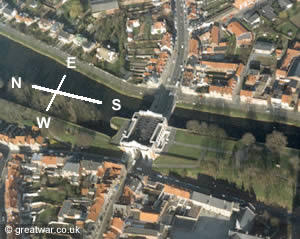 |
The location of the Menenpoort at the eastern exit of Ypres (Ieper) was considered a fitting place for one of the Memorials to the Missing for the thousands of British and Commonwealth soldiers who have no known grave in the Ypres Salient battlefields.
Location
Access to the Menin Gate is easiest on foot. There is parking in nearby streets or in the Grote Markt (market square), which is a few minutes' walk away. Care should be taken when crossing the road which runs through the arch of the Menin Gate Memorial.
Related Topics
Menin Gate Memorial to the Missing
The Memorial to commemorate the names of over 54,000 officers and men of the United Kingdom and Commonwealth Forces who died in the Ypres Salient before 16 August 1917 and who have no known grave.
Menin Gate Memorial to the MissingOpening Ceremony at the Menin Gate, 1927
For information on the Menin Gate opening ceremony in July 1927 see:
The Menin Gate Inauguration CeremonyLast Post at the Menin Gate Memorial
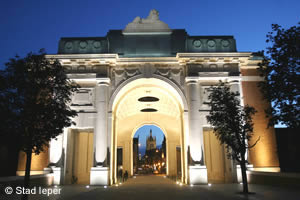
|
Every evening at 8 o'clock (20.00 hours) Last Post is played at the Menin Gate Memorial. This was started in 1927 and it has been played almost every night since except for a period in the Second World War when Ypres was occupied by German Forces.
Find out more about the Last Post Ceremony and hear a live recording of the Last Post and Réveille played at the Menin Gate:
Hear Last Post at the Menin Gate MemorialBattles in the Ypres Salient
Battles in the Ypres SalientYpres - Ieper
The city of Ypres (now known by its Flemish name of Ieper) offers all sorts of facilities and places of interest for visitors to the First World War battlfields, such as tourist information, museums, places to eat, places to stay, shops and sites of special interest relating to the 1914-1918 war. See our page at:
WW1 Museums & Archives in Australia
Australian War Memorial museum
Acknowledgements
(1) Postcard featured in Ieper in oude prentkaarten, by D Masure, no. 46
(2) The stone lion at the Australian War Memorial, Canberra courtesy of Stephen Brown.
GWPDA Photograph courtesy of Great War Primary Document Archive: Photos of the Great War
(3) Postcard series Guerre Européenne no. 42: Entrée d'Ypres - Entrance of Ypres.
(4) Photograph courtesy of the Ieper Tourist Office, copyright Stad Ieper: Tijl Capoen.
